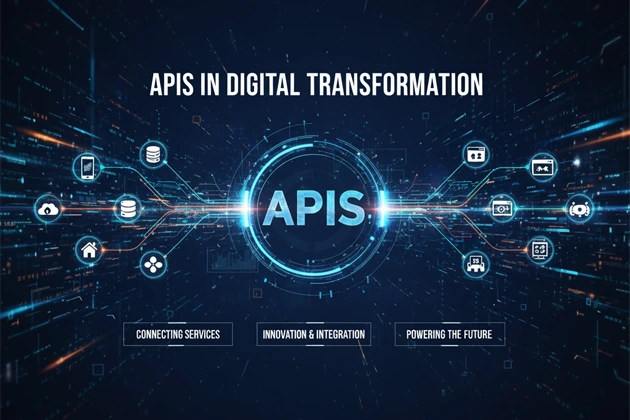Today’s organizations run on software that must interact with countless other software systems. Whether they are development software or application software, interactions between software contribute to enterprise digitization. But how can an organization give users their valuable data and computing capabilities without exposing the underlying source code and partnering with countless contributors? The application programming interface (API) describes available interactions to request and present services between similar and separate applications. This is done without actually understanding anything about the other. This layer of abstraction allows for complex interactions to be implemented.
Consider a Restaurant: Diners communicate with waiters, order from a menu, and then enjoy the meals they have ordered. Yet diners have no knowledge of how the orders are prepared, how the kitchen functions, or any complicated activities.
The menu and waitstaff are the API: the menu specifies the available options, and the waitstaff communicates and delivers those choices and manages payments. A well-designed restaurant menu and attentive waiters improve the dining experience. A well-developed enterprise API determines the scale, efficiency, and security of the provider’s interactions with end-users.
How APIs Are Beneficial for Enterprises?
Since companies are increasingly relying on software-based services to generate sales, API development and maintenance have become a significant business strategy component. A rich and diverse API ecosystem allows a company to access, process, and provide information. Then extract revenue either directly through sales or indirectly through better efficiency from those activities; this is called the API economy. APIs can be created, upgraded, and used more quickly than physical products.
Software companies and other businesses can employ a variety of API types to achieve the desired interface. Usually, Open APIs are unregulated and available to any developer, company, or user publicly. Partner APIs are intended to be used by external business partners or by organizations that have been expressly approved. Internal APIs are private interfaces between the internal systems of an organization that interact and collaborate. Composite APIs combine multiple API calls into one response to improve processing and efficiency of related tasks.
API developers can also operate with four different kinds of web service APIs:
- Simple Object Access Protocol (SOAP) APIs exchange XML-format data and are most commonly used for communications and messaging.
- A unique and proprietary XML format is used by XML-RPC that is simpler than SOAP-based APIs.
- JSON-RPC is a protocol similar to XML-RPC that uses data transfer in a JSON format.
- A collection of architectures and principles that use HTTP requests to access and use data, including PUT, GET, POST, and DELETE, is given by REST (representational state transfer).
The popularity of APIs and the number of types and protocols available to developers enable organizations to develop and deploy different combinations quickly. This doesn’t need to re-architect applications to accommodate particular business purposes or user groups.
Ultimately, APIs bring several key benefits to the company:
- B2B Collaboration: Businesses develop software to solve business problems or conduct business activities. With external software and data, a solution can exist. APIs allow one company to share the software and data that another company provides. Cloud providers, such as AWS, provide API gateways to build and offer stable APIs for developers.
- Customer Experience: The interoperability and value-adding capability of an API translate into a superior user experience, customer loyalty, and support. For example, a transport company uses an API to view routes for a map data company’s drivers. This combination makes it safer, more efficient, and more profitable for drivers. As another example, software for healthcare providers uses APIs that federate patient data from various providers, providing more comprehensive patient histories to physicians.
- Product and Service Innovation: The company’s faster speed leaves no room for mistakes or failed projects. Many companies are unable to build or supply conventional proprietary software. APIs allow even small companies to operate in the same field of play as larger businesses. APIs are smaller and more straightforward to upgrade or change than fully developed apps. It allows API providers to adapt rapidly with new or improved API offerings to changing consumer needs or new business opportunities.
- On-ramp to the public cloud: Businesses exploring the cloud’s adoption quickly recognize that APIs for cloud creation are necessary for the web to build and deliver services. APIs manage each login, provisioned resource, and data sharing between a public cloud and a cloud user. A provider-specific API, like Microsoft Azure REST API, or cross-platform APIs like Apache jclouds and Libcloud, can be chosen by businesses.
Role of APIs in Digital Transformation
By enabling seamless integration, enhancing operational efficiency, and facilitating innovation, APIs can drive digital transformation. By leveraging APIs, businesses ensure improved internal communication and process automation, which enables faster decision-making and customized services in this era of digitization. With their consistency in accessing and interacting with data, APIs play a crucial role in establishing new modes of cooperation with both internal and external partners. In today’s rapidly evolving digital landscape, such cooperation is substantially beneficial for enterprises to stay competitive and at the peak of success even in times of uncertainty.
Use Cases for APIs in the Enterprise
APIs reveal data and support communications with the organization and clients. Within the enterprise, private APIs created and deployed allow interaction between two or more in-house software platforms. Public APIs, developed and deployed to enable outside or third-party interactions, allow enterprise data and services to be used by other applications.
Dozens or even hundreds of private and public APIs could be developed, managed, and used by an enterprise. The generic design of APIs makes them invaluable in various use cases; some organizations use industry-specific APIs.
Why is it essential to have an API strategy?
The more prominent APIs’ role in the enterprise requires companies to plan their API development and management activities intelligently. It’s not enough to build and release an API—or to follow an external API—and to hope for the best. Comprehensive API management helps cohesively meet the needs of developers, apps, customers, and the organization.
A robust API strategy underscores successful enterprise mobility. While developing an application, ensuring seamless integration of mobile devices with organizational systems, enhancing user experience, ensuring security, and promoting innovation, a well-designed API strategy is essential.
A systematic, comprehensive API management approach describes the required API features and roadmaps and codifies and outlines basic API design, security, and documentation elements. With these, a company can standardize its APIs, share components and development staff, and meet desired quality and performance standards. It increases requirements for security and regulatory enforcement.
An API strategy can be beneficial for both developers and organizations. Using an API strategy, developers improve compatibility and scalability and help organizations monetize their APIs, and more. APIs are often considered a Product Strategy, where organizations capitalize on their APIs and those APIs target particular audiences to serve as a product. Enterprises must align API strategies with business objectives to ensure they keep pace with the rapidly evolving tech-driven business needs.
The CEO Views business magazine recognizes the necessity of covering trending topics concerning technology, innovation, digitalization, and others that are reimagining business operations. As a reputable business media platform, we take pride in standing at the forefront of business journalism, serving industries and communities with updated information on industries, leaders, and businesses.










